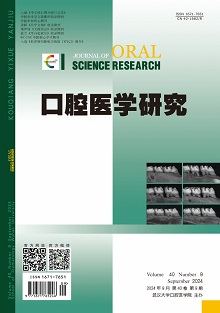|
|
Effects of Celastrol on Periodontal Tissue Injury in Periodontal Disease Rats by Regulating HMGB1-RAGE Signaling Pathway
PAN Xuan, XU Zhengmao, XIANG Guolin, XIA Shidi, JIN Song
2024, 40(9):
827-833.
DOI: 10.13701/j.cnki.kqyxyj.2024.09.013
Objective: To investigate the effect of celastrol (Cel) on periodontal tissue injury in periodontal disease (PE) rats by regulating high mobility group protein 1 (HMGB1)-advanced glycation end products (RAGE) signaling pathway and its mechanism. Methods: The periodontitisrat model was established rat model was established. The rats were separated into Control group, Model group, low, Celastrol groups [Cel-L group: 1 mg/(kg·d) Cel; Cel-M group: 2 mg/(kg·d) Cel; and Cel-H group: 4 mg/(kg·d) Cel], and Cel-H+HMGB1 recombinant protein group group (4 mg/(kg·d) Cel+R-HMGB1). The inflammation of periodontal tissue was evaluated. Microcomputedtomography asappliedtoobservethealveolarboneresorption. He hematoxylin and eosin staining and Tartrate-resistant acid phosphatase staining were applied to observe the pathological changes of periodontal tissue and the number of osteoclast. Enzyme-linked immunosorbent assay (ELISA) detected interleukin-6 (IL-6), tumor necrosis factor-α (TNF-α), and interferon-gamma. IFN-γ superoxide dismutase (SOD), Malondialdehyde (MDA), catalase CAT), reactive oxygen species (ROS), nitric oxide (NO) and prostaglandin E2 (PGE2) levels. Western blot was applied to detect the levels of HMGB1 and RAGE proteins. Results: Compared with the control group, partial loss of gingival papilla and erosion or ulcer of gingival epithelium were found in the model group, a large number of inflammatory cells were found in the gingival epithelium and lamina propria, periodontal collagen bundles were arranged irregularly, some collagen fibers were dissolved and degenerated, and alveolar bone resorption was obvious. The gingival index, gingival bleeding index, cement-to-enamel junction-alveolar bone crest (CEJ-ABC) value, the number of osteoclast in periodontal tissue, the levels of IL-6, TNF-α, and IFN-γ in serum, the levels of MDA, ROS, NO, and PGE2 in periodontal tissue, and the expressions of HMGB1 and RAGE proteins in periodontal tissue were obviously increased in rats (P<0.05). The levels of SOD and CAT in periodontal tissue were obviously reduced (P<0.05). Compared with the Model group, the alveolar bone damage and inflammatory erosion in the Cel-L, Cel-M, and Cel-H groups were reduced, the gingival index, gingival bleeding index, CEJ-ABC value, the number of osteoclast in periodontal tissue, the levels of IL-6, TNF-α, and IFN-γ in serum, the levels of MDA, reactive oxygen species (ROS), NO, and PGE2 in periodontal tissue, and the expressions of HMGB1 and RAGE proteins in periodontal tissue of rats were obviously reduced (P<0.05). The levels of SOD and CAT in periodontal tissue were obviously increased (P<0.05) and dose-dependent. HMGB1 recombinant protein could reverse the inhibitory effect of celastrol on periodontal tissue injury in PE rats (P<0.05). Conclusion: Celastrol can inhibit the periodontal tissue injury in periodontal disease rats by inhibiting HMGB1-RAGE signaling pathway.
References |
Related Articles |
Metrics
|

